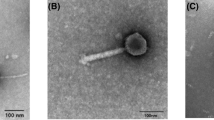Abstract
Four Salmonella bacteriophages that had been originally isolated from swine manure lagoons were characterized and compared to each other and to well-known Salmonella phages P22 and Felix 01. Host ranges of the lagoon phages were similar to each other in spot tests on reference strains of Salmonella, but differed slightly from each other on a panel of Salmonella lagoon strains. In single-step growth at 35°C the lagoon phages had latent periods of 15 to 20 min and burst sizes from 100 to 230. The lagoon phages and P22 were purified by cesium chloride (CsCl) gradient centrifugation and used to produce specific antisera and DNA. The lagoon phages were indistinguishable from each other but distinct from P22 and Felix 01 in immunodiffusion and infectivity neutralization tests and in restriction digest analysis.


Similar content being viewed by others
References
Adams MH (1959) Bacteriophages. Interscience, New York
Alisky J, Iczkowski K, Rapoport A, et al. (1998) Bacteriophages show promise as antimicrobial agents. J Infec 36:5–15
Anderson ES, Ward LR, DeSaxe MJ, et al. (1977) Bacteriophage-typing designations of Salmonella typhimurium. J Hyg Cambr 78:297–300
Borah PK, Jindal JK, Verma JP (2000) Integrated management of bacterial leafspot of mungbean with bacteriophages of Xav and chemicals. J Mycol Plant Pathol 30:19–21
Brussow H (2005) Phage therapy: the Escherichia coli experience. Microbiol 151:2133–2140
Calvo C, Brault J, Alonso JM, et al. (1981) New waterborne bacteriophages active on Yersinia enterocolitica. Appl Environ Microbiol 42:35–38
Carey-Smith GV, Billington C, Cornelius AJ, et al. (2006) Isolation and characterization of bacteriophages infecting Salmonella spp. FEMS Microbiol Lett 258:182–186
Carlson K (1994) Single-step growth. In: Karam JD (ed) Molecular biology of bacteriophage T4. American Society for Microbiology, Washington, DC, pp 434–437
El-Shibiny A, Connerton PL, Connerton IF (2005) Enumeration and diversity of Campylobacters and bacteriophages isolated during the rearing cycles of free-range and organic chickens. Appl Environ Microbiol 71:1259–1266
Farmer JJ III, Hickman FW, Sikes JV (1975) Automation of Salmonella typhi phage typing. Lancet 2(7939):787–790
Goode D, AllenVM, Barrow PA (2003) Reduction of experimental Salmonella and Campylobacter contamination of chicken skin by application of lytic bacteriophages. Appl Environ Microbiol 69:5032–5036
Greer GG (2005) Bacteriophage control of foodborne bacteria. J Food Prot 68:1102–1111
Harcombe WR, Bull JJ (2005) Impact of phages on two-species bacterial communities. Appl Environ Microbiol 71:5254–5259
Hudson JA, Billington C, Carey-Smith G, et al. (2005) Bacteriophages as biocontrol agents in food. J Food Prot 68:426–437
Huff WE, Huff GR, Rath NC, et al. (2005) Alternatives to antibiotics: utilization of bacteriophage to treat colibacillosis and prevent foodborne pathogens. Poultry Sci 84:655–659
Kudva IT, Jelacic S, Tarr PI, et al. (1999) Biocontrol of Eschericia coli O157 with O157-specific bacteriophages. Appl Environ Microbiol 65:3767–3773
Kuhn J, Suissa M, Chiswell D, et al. (2002) A bacteriophage reagent for Salmonella: molecular studies on Felix 01. Int J Food Microbiol 74:217–227
Kuhn J, Suissa M, Wyse J, et al. (2002) Detection of bacteria using foreign DNA: the development of a bacteriophage reagent for Salmonella. Int J Food Microbiol 74:229–238
Leverentz B, Conway WS, Alavidze Z, et al. (2001) Examination of bacteriophage as a biocontrol method for Salmonella on fresh-cut fruit: a model study. J Food Protect 64:1116–1121
Levin BR, Bull JJ (2004) Population and evolutionary dynamics of phage therapy. Nat Rev Microbiol 2:166–173
McLaughlin MR, Balaa MF (2006) Enhanced contrast of bacteriophage plaques in Salmonella with ferric ammonium citrate and sodium thiosulfate (FACST) and tetrazolium red (TZR). J Microbiol Meth 65:318–323
McLaughlin MR, Balaa MF, Sims J, et al. (2006) Isolation of Salmonella bacteriophages from swine effluent lagoons. J Environ Qual 35:522–528
Miller AJ, Eblen BS Oser A, et al. (1998) Application and evaluation of male-specific bacteriophage as a process integrity or faecal contamination indicator in a port slaughterhouse. J Appl Microbiol 85:898–904
Mizoguchi K, Morita M, Fisher CR, et al. (2003) Coevolution of bacteriophage PP01 and Escherichia coli O157:H7 in continuous culture. Appl Environ Microbiol 69:170–176
Modi R, Hirvi Y, Hill A, et al. (2001) Effect of phage on survival of Salmonella enteritidis during manufacture and storage of cheddar cheese made from raw and pasteurized milk. J Food Prot 64:927–933
O’Flynn G, Ross RP, Fitzgerald GF, et al. (2004) Evaluation of a cocktail of three bacteriophages for biocontol of Escherichia coli O157:H7. Appl Environ Microbiol 70:3417–3424
Pao S, Randolf SP, Westbrook EW, et al. (2004) Use of bacteriophages to control Salmonella in experimentally contaminated sprout seeds. J Food Sci 69:M127–M130
Schuch R, Nelson D, Fischetti VA (2002) A bacteriolytic agent that detects and kills Bacillus anthracis. Nature 418:884–889
Skurnik M, Strauch E (2006) Phage therapy: facts and fiction. Int J Med Microbiol 296:5–14
Thiel K (2004) Old dogma, new tricks—21st century phage therapy. Nature Biotechnol 22:31–36
Toro H, Price SB, McKee S, et al. (2005) Use of bacteriophages in combination with competitive exclusion to reduce Salmonella from infected chickens. Avian Dis 49:118–124
Weld RJ, Butts C, Heinemann JA (2004) Models of phage growth and their applicability to phage therapy. J Theor Biol 227:1–11
Welkos S, Schreiber M, Baer H (1974) Identification of Salmonella with the O-1 bacteriophage. Appl Microbiol 28:618–622
Withey S, Cartmell E, Avery LM, et al. (2005) Bacteriophages—potential for application in wastewater treatment processes. Sci Total Environ 339:1–18
Acknowledgments
We thank John P. Brooks for PCR confirmation of Salmonella lagoon isolate identifications and Renotta K. Smith and Bridget Sutton for technical assistance. This work was partially supported from Research Grant 2P20RR-16481 from the National Center for Research Resources to Rodney A. King.
Author information
Authors and Affiliations
Corresponding author
Additional information
Mention of a trade name, proprietary product, or specific equipment does not constitute a guarantee, warranty, or endorsement by the USDA and does not imply its approval to the exclusion of other products that may be suitable.
Rights and permissions
About this article
Cite this article
McLaughlin, M.R., King, R.A. Characterization of Salmonella Bacteriophages Isolated from Swine Lagoon Effluent. Curr Microbiol 56, 208–213 (2008). https://doi.org/10.1007/s00284-007-9057-9
Received:
Accepted:
Published:
Issue Date:
DOI: https://doi.org/10.1007/s00284-007-9057-9




